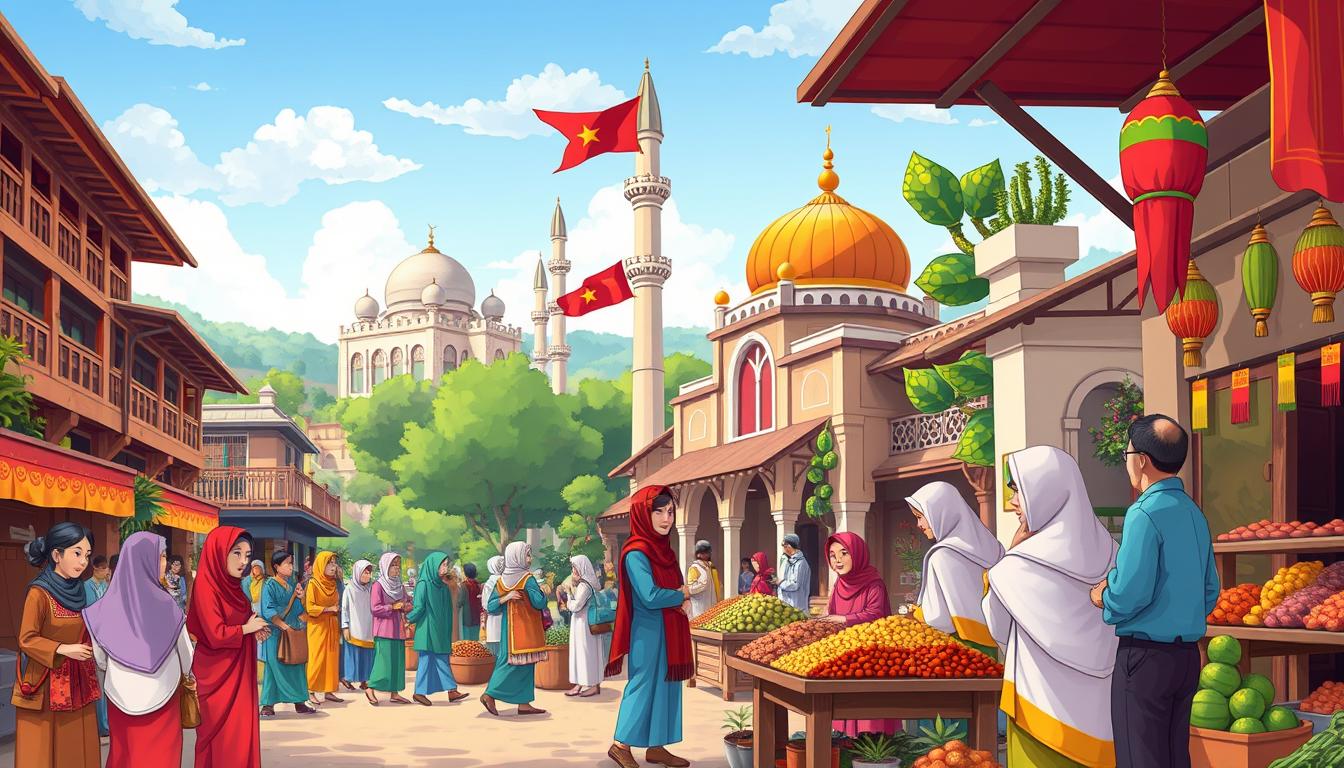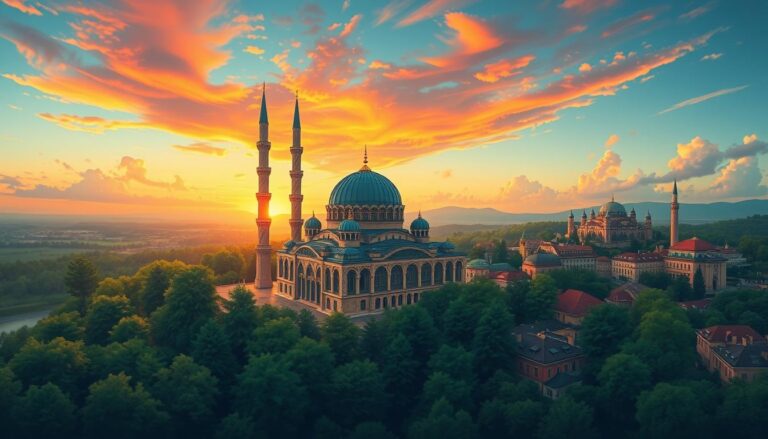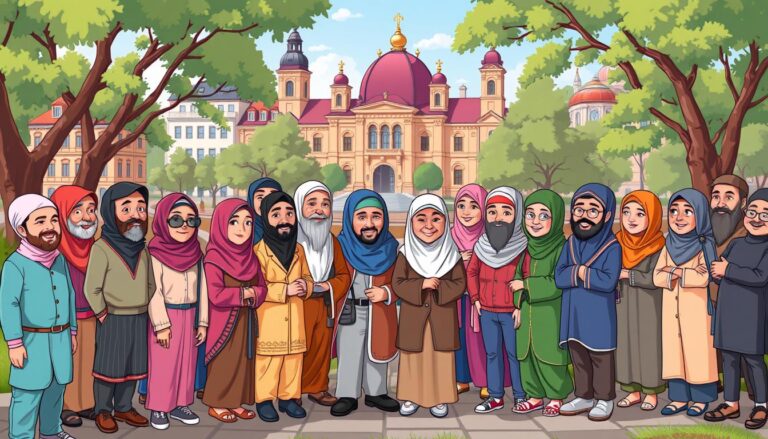Islam in Vietnam
While the religious demographics of Vietnam are dominated by folk religions and Buddhism, Islam maintains a small but significant presence in the country. In fact, less than 0.2% of the Vietnamese population identifies as Muslim, a statistic that may come as a surprise to many. This minority faith has a rich and intriguing history, woven into the cultural tapestry of Vietnam.
Vietnam’s religious diversity is multifaceted, with Buddhism, Catholicism, Protestantism, Hoahaoism, and Caodaism all representing sizable portions of the population. However, the Muslim community, primarily associated with the Cham ethnic minority, plays a unique role in shaping the country’s religious landscape.
Key Takeaways
- Islam in Vietnam accounts for less than 0.2% of the total population, or around 90,000 individuals.
- The Cham people, an Austronesian ethnic minority, are the primary bearers of Islamic tradition in Vietnam.
- Vietnamese Muslims have a diverse ethnic background, including Cham, Khmer, Malay, Minang, Vietnamese, Chinese, and Arab origins.
- Islam in Vietnam has a long and complex history, dating back to the 8th century and influenced by various regional and global factors.
- Despite their small numbers, Vietnamese Muslims maintain a distinct cultural identity and contribute to the country’s religious tapestry.
History of Islam in Vietnam
The Islamic history in Vietnam dates back centuries, marked by the spread of Islam through the region. Arab Muslim traders were known to make stops at ports in the Champa Kingdom as early as the 9th and 12th centuries, introducing the faith to the local Cham people.
Song Dynasty-era documents from China record that the Cham began converting to Islam in the late 10th and early 11th centuries. This period also saw the arrival of Muslim Turks and Persians in Vietnam during the Mongol invasions, further contributing to the spread of Islam in the region.
By the 17th century, the Cham provinces had been absorbed by the Vietnamese, leading to severe persecution of Cham Muslims. Many scattered along the Mekong River, forming 13 villages where children were sent to Kelantan, Malaysia, for Islamic studies before returning to teach in their communities.
Today, roughly one-third of Muslims in Vietnam are of ethnic groups other than Cham, including a community in the Chau Doc region that practices Islam with mixed ethnic origins such as Cham, Khmer, Malay, Minang, Viet, Chinese, and Arab.
The spread of Islam in Vietnam has deep historical roots, from the early contacts between Arab Muslim traders and the Cham people to the lasting impact of the Mongol invasions and the subsequent persecution of Cham Muslim communities. Today, the Muslim presence in Vietnam is diverse, with connections to various ethnic groups and a rich cultural heritage.
The Cham People and the Origins of Islam in Champa
The Cham people, an Austronesian ethnic minority group, have a rich and fascinating history intertwined with the origins of Islam in Champa, a former kingdom in what is now central Vietnam. According to scholars, Islam first appears in early Cham texts as Asulam, the term the Cham people still use today.
One of the predominant religious practices among the Cham is the Bani Awal (Bini ralaoh, people of Allah) religion, a syncretic and localized version of Shia Islam that gained dominance in the 17th century Panduranga region. Researchers have proposed two primary theories for the introduction of Islam to Champa:
- The first theory suggests that Islam could have been brought by Arab, Persian, and Indian merchants, scholars, and religious leaders from the 10th to 14th century.
- The second theory argues that Islam arrived in Champa through a later, shorter, and more indirect route from the Malays (jawa, melayu, chvea) after the fall of Vijaya in 1471.
Regardless of the exact origins, the Cham people’s conversion to Islam has had a significant impact on their culture and identity, with the Shiite Bani sect becoming a crucial part of their religious and social fabric.
“The Cham people are known as Austronesian seafarers who historically populated and dominated maritime Southeast Asia.”
Islam in Vietnam
In Vietnam, the Muslim population is estimated to be around 90,000, accounting for less than 0.2% of the country’s total population. This diverse community includes Cham Muslims, local Vietnamese Muslims, and descendants of mixed marriages between Vietnamese and merchants from Arab, Indonesian, Malaysian, and Pakistani origins, as well as Muslim converts.
The Vietnamese Muslim population is predominantly concentrated in 8 cities across the country, with 62 mosques, including 17 located in the economically strongest and most populated city, Ho Chi Minh City. This small but vibrant Islamic community practices their faith, with mosques serving as hubs for religious and cultural activities.
While the Muslim population in Vietnam is relatively small compared to neighboring countries in Southeast Asia, the government has shown a certain level of relaxation in its attitude towards the Cham Muslim community. This includes allowing permits for the expansion or construction of mosques, facilitating local and international fundraising for mosque projects, and the translation and distribution of Islamic literature.
However, the Cham Muslim community in Vietnam still faces educational challenges, as most members are poorly educated, with school attendance not being compulsory and children often needed for labor in the fields and at home. Additionally, Cham students have limited opportunities to study abroad due to financial constraints and low academic qualifications.
Despite these challenges, the presence of Islam in Vietnam, though modest, continues to be an integral part of the country’s diverse religious landscape, showcasing the coexistence of various faiths within the nation.
Contradictory Narrative and Malay Origin of Cham Islam
The origins of Islam in Champa, a once-powerful kingdom in central Vietnam, have long been a subject of scholarly debate. While some historians suggest a direct connection to Arab and Persian influences, a more convincing theory has emerged that points to the Malay Peninsula as the primary source of Cham conversion to Islam.
After the fall of the Cham capital Vijaya in 1471, the Cham people experienced a diaspora, with many merchants, warriors, and refugees adopting Islamic faiths from their Malay counterparts through peaceful interactions. These Cham Muslims then returned to their homeland and began preaching their newfound faith to their fellow citizens by the 1500s, marking a significant chapter in the Malay influence on Cham Islam.
Malay Influence on Cham Islam
The Cham’s proximity to the Malay world, coupled with the rise of global trade during the Age of Exploration, facilitated the spread of Islam through the Cham diaspora. As Cham Muslims ventured across Southeast Asia, they forged strong relationships with Malay communities, further reinforcing the origins of Islam in Champa.
“The Cham people in central Vietnam are among the earliest mainland Southeast Asian converts to Islam reported in the mid-8th century.”
This narrative, however, is not without its critics, as some scholars argue for a more direct connection between the Cham and the Persian and Arab worlds. Nevertheless, the Malay influence on Cham Islam remains a compelling and widely accepted theory among historians studying the Cham conversion to Islam.
Religious Diversity in Vietnam
Vietnam is a land of extraordinary religious diversity, where a tapestry of beliefs and traditions coexist harmoniously. While the majority of Vietnamese do not follow any organized religion, they actively participate in the practices of folk religions, such as venerating ancestors or praying to deities. This rich spiritual heritage is deeply ingrained in the country’s cultural fabric.
Buddhism, the largest organized religion in Vietnam, has a long and storied history, with an estimated 27% of the population identifying as Buddhist practitioners. Additionally, Vietnam hosts the second-largest Roman Catholic population in Southeast Asia, with around 7 million adherents.
- Vietnam is home to 46 registered faith groups and 16 recognized religions, as of August 2023.
- The government recognizes seven Islamic religious organizations within the country, reflecting the presence of Islam in Vietnam’s diverse religious landscape.
- Despite the government’s efforts to regulate religious activities, Christian and other faith communities have expressed a willingness to build bridges with authorities and contribute to local and national development.
However, the true extent of religious practices in Vietnam is not fully captured by government statistics, as they do not accurately account for the widespread adherence to folk religion, which is not officially recognized by the state. This underscores the remarkable religious diversity that thrives within the country, defying simple categorization and demonstrating the resilience of Vietnam’s spiritual heritage.
“Vietnam is a land of extraordinary religious diversity, where a tapestry of beliefs and traditions coexist harmoniously.”
Vietnamese Folk Religion
In Vietnam, the resurgence of traditional beliefs and the veneration of local, village-level spirits are integral parts of the country’s vibrant Vietnamese folk religion. One distinct branch of this folk tradition is Đạo Mẫu, a form of shamanism involving the worship of mother goddesses such as Thiên Y A Na, Bà Chúa Xứ, Bà Chúa Kho, and Liễu Hạnh, as well as legendary figures like Âu Cơ, the Trưng Sisters, and Lady Triệu.
Đạo Mẫu and Spirit Mediumship
Đạo Mẫu is commonly associated with spirit mediumship rituals, known in Vietnam as lên đồng, in which followers become spirit mediums for various deities. These rituals are an integral part of the Vietnamese ancestor veneration tradition, as they allow believers to communicate with their ancestors and seek their guidance.
“The practice of Đạo Mẫu has endured for centuries, reflecting the deep-rooted connection between the Vietnamese people and their spiritual heritage.”
While officially discouraged during the communist era, Đạo Mẫu has experienced a resurgence in recent decades, with many Vietnamese people rediscovering the cultural and spiritual significance of this ancient tradition.
Buddhism in Vietnam
Vietnam has a rich and diverse religious landscape, with Buddhism playing a prominent role in the country’s spiritual and cultural heritage. Mahayana Buddhism, first spreading from India via sea routes around 100 AD, has taken root and flourished in Vietnam over the centuries, with more than half of the Vietnamese population considering themselves adherents of this tradition.
Alongside Mahayana Buddhism, Theravada and Hòa Hảo Buddhism also have a significant presence in the country. The practice of Buddhism in Vietnam, however, differs from that of other Asian nations, with a greater emphasis on devotional rituals rather than meditation, and a symbiotic relationship with Taoism, Chinese spirituality, and the indigenous Vietnamese religion.
According to government data, there are over 26.5 million believers in Vietnam, accounting for 27% of the country’s population. The Buddhist community, formally registered with the Vietnam Buddhist Sangha (VBS), is estimated to have around 5 million followers, constituting 35% of the total number of religious adherents nationwide and 5% of the overall population.
Despite the prominence of Buddhism, Vietnam’s religious landscape is characterized by diversity, with the government officially recognizing 16 religions and 43 religious organizations. The Southeast provinces and Southwest regions have the highest concentration of religious followers in the country, while the Northern region accounts for 13.90% of believers.
While Vietnam upholds the principle of freedom of belief and religion, the country has faced international criticism for not fully exercising this freedom in practice. The United States Commission on International Religious Freedom (USCIRF) has designated Vietnam as a “country of particular concern” for its restrictions on religious activities, and Freedom House has rated the country low in terms of individual freedom to practice religious faith.
Islam in Vietnam Today
The Muslim population in Vietnam is estimated to be around 90,000, making up less than 0.2% of the total population. Vietnamese Muslims predominantly live in 8 cities across the country and have 62 mosques, with 17 located in Ho Chi Minh City. The Vietnam Islamic Centre is the sole authorized body for attending to the needs of Muslims in the country.
Despite their small numbers, Vietnamese Muslims face significant challenges in accessing Islamic education and resources. They also experience psychological oppression due to the dominance of Buddhism in the country’s social and cultural life. Many are calling out to international NGOs for support in areas such as food aid, orphan sponsorship, and the construction of Islamic facilities.
While the Vietnamese government is working on promoting religious tolerance and freedom of belief, discrimination against Muslims still persists. The Muslim community in Vietnam continues to contribute significantly to the country’s economy, with many entrepreneurs running successful businesses. Their unique Islamic architecture and influence on popular Vietnamese dishes, like pho and banh mi, are a testament to the rich cultural diversity in the country.
“We are a small community, but we are proud of our faith and heritage. We hope to see more support and understanding from the government and our fellow citizens.”
Conclusion
Islam has a long and complex history in Vietnam, with the Cham people being the primary adherents. While the Muslim population in Vietnam is small, at less than 0.2% of the total population, the country’s religious diversity is reflective of its rich cultural heritage. Vietnamese Muslims face challenges in preserving their faith and accessing resources, but they continue to strive to maintain their traditions and connections with the global Muslim community.
The Islamic history in Vietnam dates back to the 8th century, with the Cham people playing a significant role in the spread of Islam throughout the region. Over the centuries, the Cham community has faced numerous challenges, including political turmoil, wars, and cultural assimilation. However, they have persevered in preserving their unique identity and religious practices, as seen in the continued presence of Cham villages, mosques, and weaving traditions.
Today, Islam in Vietnam is a minority religion, yet it remains an integral part of the country’s diverse religious landscape. The Cham people continue to be the backbone of the Muslim population in Vietnam, with their cultural and religious practices intertwining with other belief systems, such as Animism, Buddhism, and Taoism. As Vietnam continues to evolve, the role and experiences of its Vietnamese Muslims will undoubtedly continue to shape the country’s rich tapestry of religious diversity.
Source Links
- Religion in Vietnam
- İHH Humanitarian Relief Foundation
- Islam in Vietnam
- History of Islam in Vietnam
- Chams
- Cham Ethnic Minority Group
- ISIM-Newsletter-02
- Islam in Vietnam: The Formation & Development
- Religions of Ethnic minorities in Vietnam – Open Development Vietnam
- Persian Kings, Arab Conquerors and Malay Islam: Comparative Perspectives on the Place of Muslim Epics in the Islamisation of the Chams
- Praxis and policy: Discourse on Cham Bani religious identity in Vietnam | Journal of Southeast Asian Studies | Cambridge Core
- No title found
- 4. Practices
- Country Update: Religious Freedom Conditions in Vietnam in 2023
- Beliefs & Religions | Embassy of the Socialist Republic of Vietnam in the United States
- Religion and Belief | About Vietnam
- No title found
- Overview of Religions in Vietnam – Open Development Vietnam
- Vietnam – United States Department of State
- Vietnam – United States Department of State
- Islam in Vietnam: From Champa Kingdom to Modern Times
- How Vietnam respects and protects religious freedom has implications beyond its own borders
- Religions of Vietnam







